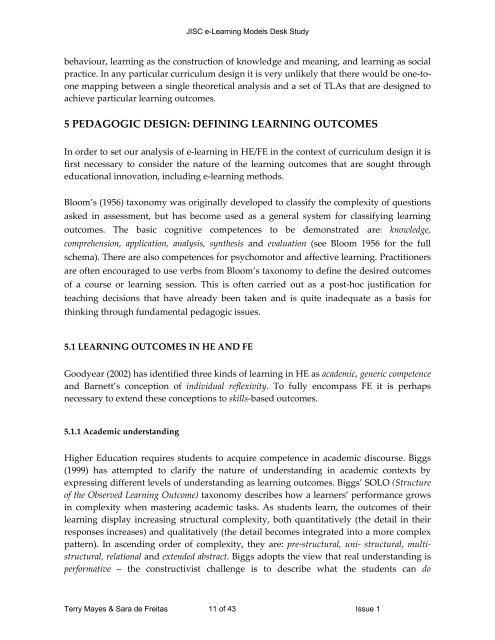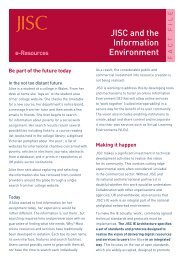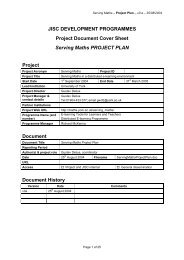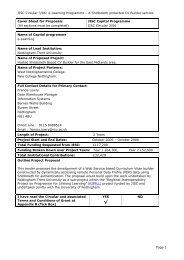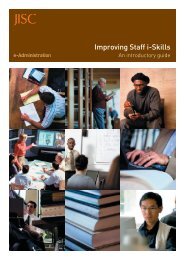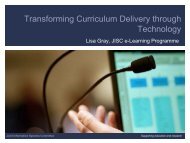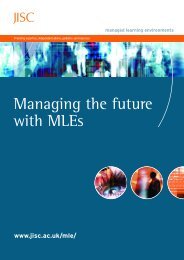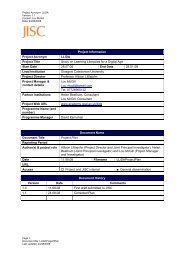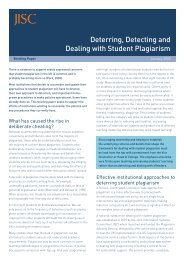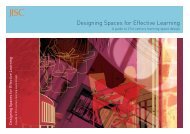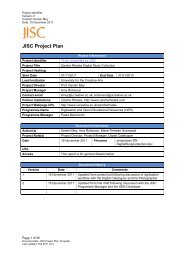Review of e-learning theories, frameworks and models - Jisc
Review of e-learning theories, frameworks and models - Jisc
Review of e-learning theories, frameworks and models - Jisc
You also want an ePaper? Increase the reach of your titles
YUMPU automatically turns print PDFs into web optimized ePapers that Google loves.
JISC e-Learning Models Desk Study<br />
behaviour, <strong>learning</strong> as the construction <strong>of</strong> knowledge <strong>and</strong> meaning, <strong>and</strong> <strong>learning</strong> as social<br />
practice. In any particular curriculum design it is very unlikely that there would be one-toone<br />
mapping between a single theoretical analysis <strong>and</strong> a set <strong>of</strong> TLAs that are designed to<br />
achieve particular <strong>learning</strong> outcomes.<br />
5 PEDAGOGIC DESIGN: DEFINING LEARNING OUTCOMES<br />
In order to set our analysis <strong>of</strong> e-<strong>learning</strong> in HE/FE in the context <strong>of</strong> curriculum design it is<br />
first necessary to consider the nature <strong>of</strong> the <strong>learning</strong> outcomes that are sought through<br />
educational innovation, including e-<strong>learning</strong> methods.<br />
Bloom’s (1956) taxonomy was originally developed to classify the complexity <strong>of</strong> questions<br />
asked in assessment, but has become used as a general system for classifying <strong>learning</strong><br />
outcomes. The basic cognitive competences to be demonstrated are: knowledge,<br />
comprehension, application, analysis, synthesis <strong>and</strong> evaluation (see Bloom 1956 for the full<br />
schema). There are also competences for psychomotor <strong>and</strong> affective <strong>learning</strong>. Practitioners<br />
are <strong>of</strong>ten encouraged to use verbs from Bloom’s taxonomy to define the desired outcomes<br />
<strong>of</strong> a course or <strong>learning</strong> session. This is <strong>of</strong>ten carried out as a post-hoc justification for<br />
teaching decisions that have already been taken <strong>and</strong> is quite inadequate as a basis for<br />
thinking through fundamental pedagogic issues.<br />
5.1 LEARNING OUTCOMES IN HE AND FE<br />
Goodyear (2002) has identified three kinds <strong>of</strong> <strong>learning</strong> in HE as academic, generic competence<br />
<strong>and</strong> Barnett’s conception <strong>of</strong> individual reflexivity. To fully encompass FE it is perhaps<br />
necessary to extend these conceptions to skills-based outcomes.<br />
5.1.1 Academic underst<strong>and</strong>ing<br />
Higher Education requires students to acquire competence in academic discourse. Biggs<br />
(1999) has attempted to clarify the nature <strong>of</strong> underst<strong>and</strong>ing in academic contexts by<br />
expressing different levels <strong>of</strong> underst<strong>and</strong>ing as <strong>learning</strong> outcomes. Biggs’ SOLO (Structure<br />
<strong>of</strong> the Observed Learning Outcome) taxonomy describes how a learners’ performance grows<br />
in complexity when mastering academic tasks. As students learn, the outcomes <strong>of</strong> their<br />
<strong>learning</strong> display increasing structural complexity, both quantitatively (the detail in their<br />
responses increases) <strong>and</strong> qualitatively (the detail becomes integrated into a more complex<br />
pattern). In ascending order <strong>of</strong> complexity, they are: pre-structural, uni- structural, multi-<br />
structural, relational <strong>and</strong> extended abstract. Biggs adopts the view that real underst<strong>and</strong>ing is<br />
performative – the constructivist challenge is to describe what the students can do<br />
Terry Mayes & Sara de Freitas 11 <strong>of</strong> 43 Issue 1


